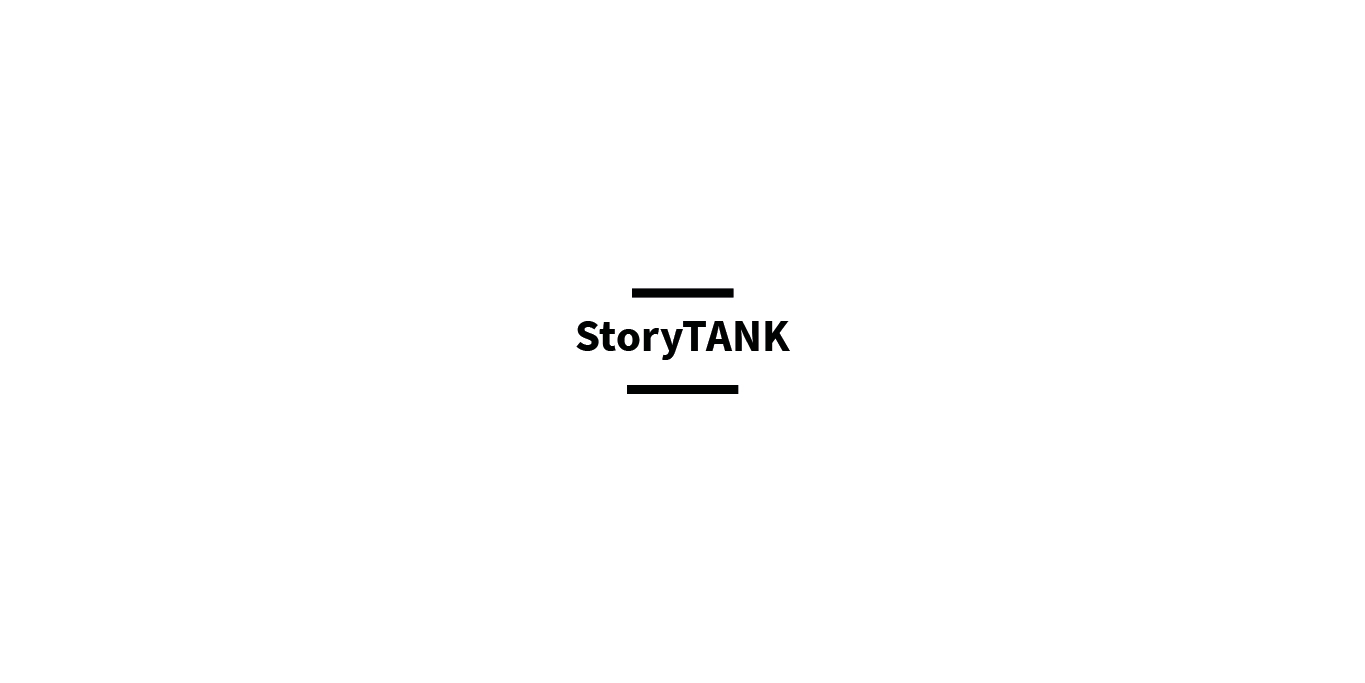— conference recorded at Les Champs Libres (Rennes) in December 2023 in the framework of the series “What stories for our time?”, moderated by Yann Apperry – Screenwriter, Playwright and Novelist – and Nicolás Buenaventura – Writer-director and Storyteller.
While the stories of a world in crisis are hitting us, how can we not fall into madness?
Can we think of stories as way to re-weave ourselves, as an individual and collective reconstruction?
With Roberto Beneduce – ethnopsychiatrist and anthropologist, Julie Budtz Sørensen – Danish screenwriter, Tamara Russell – neuroscience and martial arts specialist & Mathilde Delespine – Midwife, coordinator of the Maison des femmes Gisèle Halimi at Rennes University Hospital
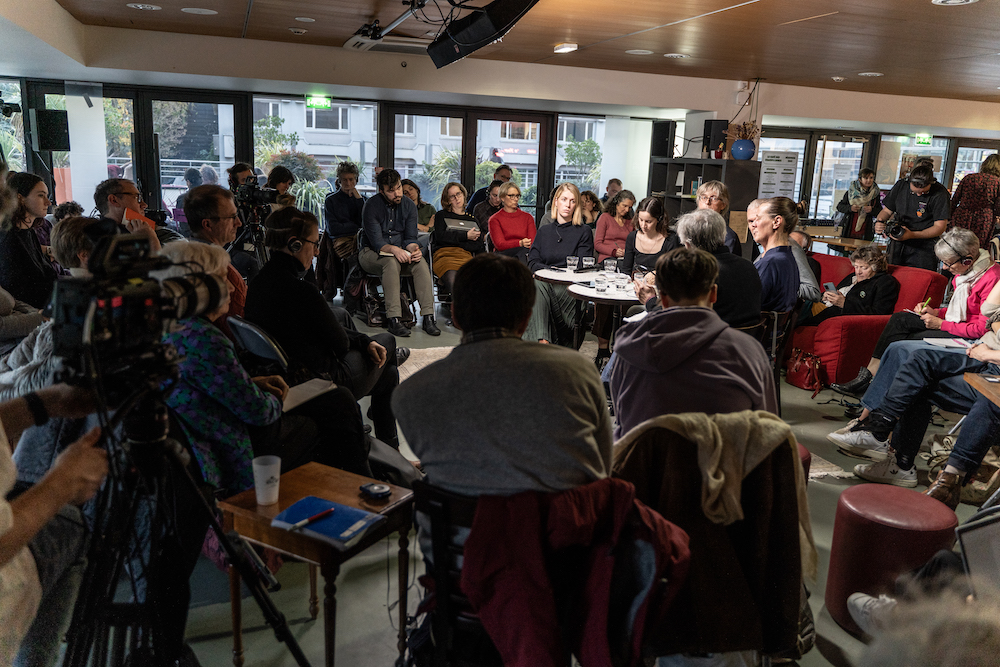
Tamara Russell
From the “we” to the “I”.
So I suppose the thing that’s been preoccupying me, as I engage with the world through the lens that I have, which is neuroscience and martial arts, is trying to think about the conception of a story in terms of, is it a thought? Is it a movement? Is it a mental movement that comes from he imagination? Is it a heart movement that inspires us through feeling and sensing, and the role of the physical body and the physical movements as part of that conceiving of a story?
The place where I often come back to, particularly when I’m struck and pained by the state of the world, a collective psychosis, some have referred to it as a madness, that we’ve become trapped in or stuck in, is, again, where does that reside in us as individuals?
Because my sense is, if we need to curate collective stories, there’s a self-responsibility that we first examine our own stories as individuals.
So in that movement from I to “we”, we don’t just jump over the “I” and suddenly go to the we and discover that we’re carrying a lot of our own wounds and pains and biases with us.
And if I think about healing stories and healing journeys, what the martial arts has taught me is there’s a lot we can do for our own healing if you’re able to feel into your own wounds, whether those are physical, psychological, or mental.
From the inner to the outer.
So, this idea of being a researcher of our own experience through sensing, through touch, allowing us to contact our own wounds and pains, which then opens that doorway to be more compassionate when we’re engaging with the wounds and the pains of others around us.
Listening to make sense.
What happens when information comes into our brain when we’re listening? Very naturally, our brain is trying to organize and make sense of that information. And quite quickly, it brings up as many of the experiences that we can connect to as possible, because it’s kind of sorting through and trying to make sense, like, do I have an experience of this? Can I connect to this in some way? So we have this natural propensity to try to make sense of that information in relation to our own experience. And that’s not wrong or bad, but the awareness of that and the power that may come from that, particularly if you’re in a hierarchical position as a therapist or as a doctor.
Open listening to stay connected.
How do I listen without problem solving?
How do I listen without sort of pre-emptively diagnosing? And I mean, for me, mindfulness practice, meditation practice has been essential for that, because I’m able to sort of spot it arising more quickly and mostly able to deal with it.
Body and words.
I think the body, for me, is always a teacher and a tool, and especially important when words are hard to find, which may be for a variety of reasons. And for me, there’s an interesting practice, which is really tuning in to the intention to make a movement and trying to observe how that decision, which is made by our frontal lobe, starts to then prepare the body, that thing that the brain does, which is bringing up past experiences and coding all the information for how to make the movement, before then sending the movement out into the body.
References and potential.
How can I make a movement that I’ve never made before? What you’re actually activating at the brain level is something that the neuroscientists refer to as “free won’t”. So, it’s not about free will. It’s about the letting go to create the space for the potentiality. Think of a baby, how they begin to explore the world. They haven’t yet got the movement of walking. They’re trying every different adaptation of foot placement and angle and hip and head, super focused concentration. And slowly that becomes honed into an automatic movement that can be made without awareness. But can we as adults practice walking as if walking for the first time? Intention, attention, awareness, sensing the world, mindful walking…
Automatisms and first times.
When we meet somebody that our brain is like, I’ve got no reference for this. I’m like really stuck and I’m going to just fill it with all my preconceptions and prejudices because I’ve got nothing. Those for me are moments when moving together: following, mirroring, we’re activating the brain’s mirror neurons. Part of that network, social network of empathy and bonding.
Respect for the appropriation of the narrative.
We’ve talked about the language of safety, whether that’s safety for the characters and the performers, even, of a show or a film.
What’s safe enough to expose people to? Through a work of art or through storytelling. And recognizing that the fear experienced in the Congo Republic may be different from the fear experienced by someone walking down the streets of New York. But the fear is the fear in the brain, it’s a very particular constellation of neural networks that will activate in certain ways when cortisol is flooding the brain.
To put in safety to open the consciences.
I can feel safe with you. How do we create safe enough spaces and containers that can allow us then to stretch a little bit more the brain salience network? The salience network is activated, it’s got different tones to it and there’s maybe some nuance there. Like if we want to open awareness, you know, it doesn’t have to be that big fist of shocking violence and gore, the more implicit, the subtler.
The micro-details of the narrative.
It’s in the micro. It’s in the micro moments of connection. It’s in the micro moments of a smile or a gesture or a touch. In the screenwriting, too, it’s that little thing that maybe half the audience missed. But there was that little clue that something shifted.
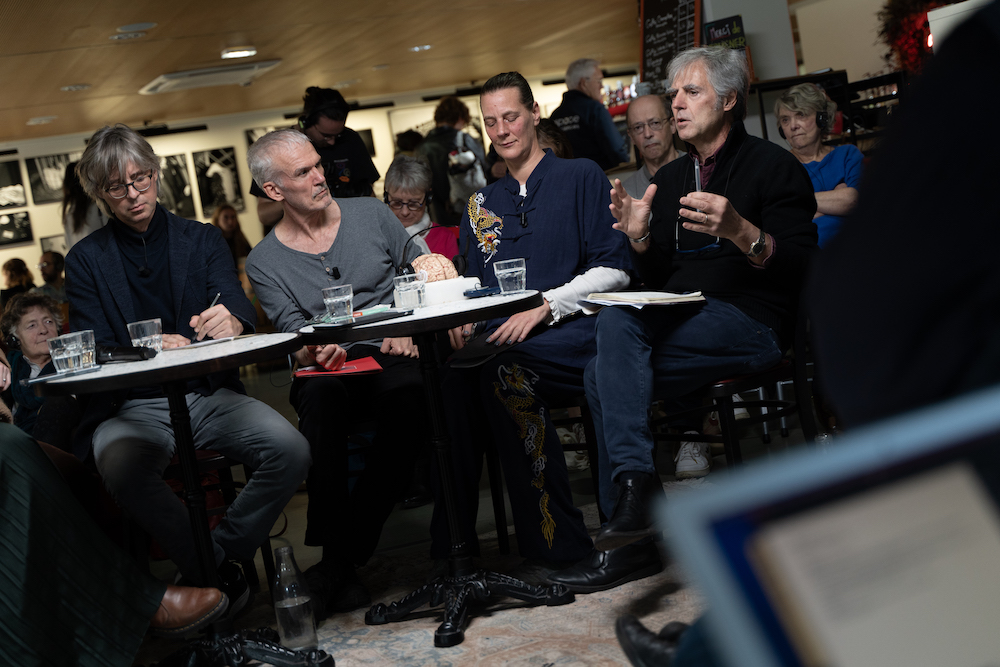
Roberto Beneduce
Linguistic hegemony: a danger of our time.
I started resisting the violence of a single language when I started to work with the mad people in a peripheral area of my birth town Naples. I entered the forest of different languages and stories. They were mad people, but they were poor men and women too. I think that people were victims of this linguistic violence when obliged to speak about themselves in the language of psychiatry. I think that we have to consider this violence of linguistic hegemony as a danger of our time. It is an example of linguistic terrorism, obliging people to reduce their experience, their multiplicity of languages to one dominant language. And this experience was for me the first time when I started to question the relationship between my knowledge and the experience of other people.
Healing the other: co-writing.
The question “how stories, words can heal”: I think that we have to put first another question. Are we ready to hear the words of people? Are we ready to hear other ways of narrating time, experience, body, and so on?
When I started to study anthropology and I took my PhD and worked in West Africa, this experience amplified, became more and more complex because I worked with local healers, working with mental disorders.
And for me, this was another forest of languages, symbols, strategies, worlds. In this case, too, I learned my ignorance and it was an important experience. Healing the other is not giving them a truth, but co-writing a truth and co-imagining a story.
Listening again and again.
The experience realized during my last 28 years with migrants was for me another bomb because I was obliged to, again, to reimagine the way of hearing their truth, their lies, their experience.
Multiply the language.
We have to multiply the language, including in our job as clinicians, as scholars, as writers, poets, as always, other codes.
The colors of our words.
The first thing to recognize is the fact that in our language, there are many, many levels, profiles. And if I want to construct, to build, another setting, I have to be aware about what my words hide. It is an effort with myself to control my words as well as to control my eyes, because even my look can be violent and a powerful look.
The fragmented language.
The powerless language is characterized by its ontological fragility, its ontological lack of consistency.
Many times, people speak, and the first comment is: “I don’t understand. She speaks about too many things together.” People speak as they live. Life is without any consistency. Migrant people try to save all their life in another language, obliged to translate their body, their gesture in another world. The language of powerless people is a shy language. It’s a language characterized by a sort of a “shame”. It is a shameful language, hesitant language. Even when people cry with aggressively, they are shameful, because their cry is a desperation language.
Recognize fragments of the unknown.
A scenario that wants to give, to resituate this richness, must recognize these fragments, reimagining their place and their definition. The cries, the lack of consistency maybe is a shortcut for a myth, for a cultural perspective, for a cultural memory that we completely ignore.
Time is the secret of a successful story.
Step by step, I enter another world. This means that we need time. And another disease of how our time is the lack of time for hearing people. Again, are we ready to hear other narratives, other stories? This is the challenge.
Each kind of story, I think, is a sort of architecture, a new architecture of time, a sort of blockage of time, a suspension of time. Even the series you prepare give another time. It is important, because if you consider that even therapeutic rituals operate with the same logic, blocking the time. In this blocked time, people can imagine another experience, project, wait for another story. So, this way of working with time is the secret of each successful therapy, the secret of each successful story,
Story-sellers
Today, there are many, many story-sellers, you know, in migration field, story-sellers multiplied: these people whose profession is to sell against money a narrative to the migrant before he or she stands before… To be credible. To receive the humanitarian protection. I think that it is a new field to reimagine our way of considering story, epic, narrative, novel, and so on.
The symbolism of the first name.
Unfreeze words, detrivialize words.
If you consider the first name, stay about your first name and make the story about your first name.
In West Africa, touching the first name is touching a secret, you touch a danger, you touch a rule, a story of a village.
Metaphors to create bridges between time and place.
Working by metaphors means that you create an imaginative code. And this is obvious because metaphors are able to “connect”, making bridges between times and places. And we know that places have memories. But usually, we speak about our body, our individuality, and we forget the relationship between my body and the spaces and the places that we touched before. For instance, I was speaking with a woman coming from DRC, Lake Goma. And she was blocked because she was raped near the lake. And when I told her, “I know this lake, I know this town. In that town, you prepare a very good fish.” She smiled. And she started again to imagine a possibility for her body to live in this world, even if this world is a world of violence, death, humiliation. So it is a continuing work where we have to discover step by step with the other people, where place themselves, where place ourselves in this movement.
Increase the semiotic orientation.
I think that when people prepare a scenario for TV, for cinema, they multiply these signs because they don’t want to give people a complete story. They give the possibility of identifying themselves in this forest of science of semiotic.
The narrative paradigm in society.
In many cases, we are not ready to listen to traumatic experiences coming from other countries, from other regions of the world. A colleague of mine coming from Africa said, “you Europeans, you Westerners, you are not ready for our trauma.” And I think he was right. Because what happens in many parts of the world, we just translate in our categories. So, we watch them, we translate in medical terms, but the problem remains invisible.
I think that trauma doesn’t need to be to be saved, to be made explicit. Living under the empire of narrative paradigm in our society, we think that we have to say all things. It is not necessary. The clinical work, the very fine research is to be placed next to things, next to an experience, not necessarily explicit them, cutting them. This is a surgery work, not psychological, psychotropic work. What is important is communicating to other people that we are there, ready to listen, ready to help.
The collective narrative for individual metamorphoses.
The story to reintegrate our world.
The first metamorphosis, an effective story has to realize is reconnecting the individual, the people, to someone else. Recreating a minimum of shared memory and link. If the healer, if the clinician, is the only one, it is just important to reimagine a micro community between me and you. We are recreating the first minimal exchange and reintegration. And step by step, this reintegration is the metamorphosis being again in a possible world against the end of the world, against the risk of apocalypse.
Today, all of us know the anxiety of distrust. People, migrants came here and they are object of suspicion and reciprocally, they distrust our world. How you can heal these people if you are not able to reconstruct a minimum of community? This reintegration is the first step of a metamorphosis.
An epic and not tragic story.
Our effort is toward humiliated people. The effort of making an epic story about their miserable story. “You are not just a victim. You are not just ill people. You are not just a disparate man.” We have to transform in an epic sense, his or her trajectory. Each therapy has to realize this metamorphosis.
We can introduce to these humiliated, wounded, shamed bodies, a word of grace. We have to introduce these little miracles in our stories.
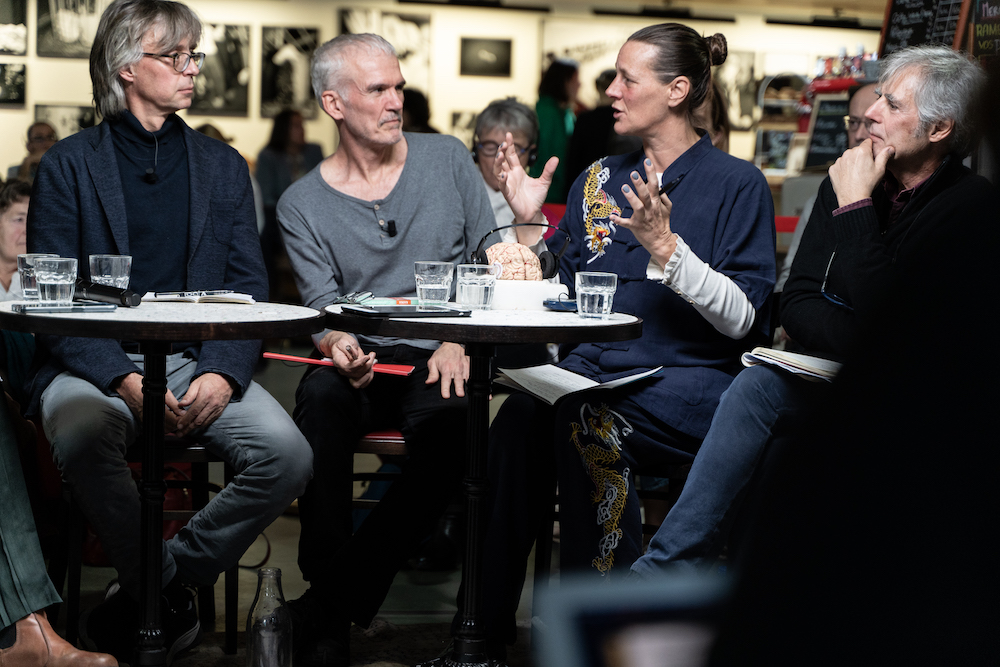
Julie Budtz Sørensen
Intimate and collective.
As a scriptwriter working with cinema, mostly with television, I’m trying to find the bridge between these two worlds that are quite different: intimate and collective.
Lars von Trier, the Danish director, he said once – “a movie or a show should be like a pebble in the shoe” – and how to put that into the world of television and keep this idea while being a part of an entertainment industry that in many ways wants to get what it already has. I’m juggling this thing to make something for a broad audience that still says something about society and about some people that the viewer is maybe not that used to see in fiction or in television and cinema.
Empathy for fictional characters.
A story that I want to tell, is of course the result of a dialogue with my producers about it, but I also is a dialogue with the broadcaster, about how to tell the story in a proper way.
I think, especially in Denmark, people are quite addicted to spending their two hours on Netflix every night.
You’re following characters, and you engage in their lives. I think that is a great opportunity to learn something and feel empathetic about some fictitious characters.
The questioning of worldviews.
But it can have the opposite effect on people: becoming almost anti-social, preferring the world of fiction also because it resonates with the world view you already have. Right now, maybe there’s not that many initiatives to challenge the spectator of viewers’ world vision.
A common grammar for a common language?
We work in writers’ rooms, and we have to have a common language. And we’re taught a certain way in school with a grammar of – well, it’s back to Aristotle, but also American tradition of how to tell the story in a film, the turning points and point of no return and this… And they’re good at scratches, but if they become determining of the story, you begin there, it’s a big problem because you will always know where the story is going. But also, it’s a comfort for the viewer to watch a story you know where it’s going.
Move “under the skin” of the character.
I think in this way of connecting with what someone coming with a different story, it can be through emotions. Working with long running TV shows, it has the potential to follow a character for a long time and get under this person’s skin. So, I see it as a good challenge to be able to introduce people who come with new stories and kind of force the viewer, that sounds wrong, but to spend time with these people, because eventually you will hopefully get under their skin.
Multiply the angles for the same character.
I think also in that way, the language of cinema, like the more classical way of telling a story and using tricks like cliff-hangers and suspense, can be useful to, a bit, manipulate the viewer, but in a good way to be engaged with someone that normally they wouldn’t be engaged with. Without moralizing. So of course, it’s an exercise for me when I’m writing. But hopefully also for the people I write for, to see things from different angles. And I think in that way, for me, it’s very satisfying to work with long running format, because you can really explore different perspectives.
Collectively re-create a unique world.
What I love about working with cinema is that it’s a collaborative work. No one does it by themselves. And it resonates a bit with what you said also. You start with a vision, but it will be challenged by so many people in the process. And I think it’s extremely important, obviously, to be open to that, because it’s such a long process from the idea to the finished work. And even, of course, when you are finishing sound, even you will still be recreating the narrative of the story. Actually, I think one of the most pleasurable things is editing, because for a writer, with the editor, if you’re working with them, which you often do on a show, you are reconstructing your story with new limitations. You have the material, but it’s like a completely different way of creativity.
Addiction in storytelling.
Today, there is a junkie’s attachment to a product, a series or something. And we were wondering if addiction, isn’t a form of trauma? Are we, scriptwriters, drug dealers or are we providers of another spectrum of substances?
Tell the trauma.
I made a whole television show about a rape and a girl being raped and the main character was her best friend. I think one of the ways of me to find it like, I guess, OK to tell the story as if it was from the perspective of her friend and some perspectives that I could understand. But it’s a dilemma always. You want to tell this story, but how to tell it in a respectful way.
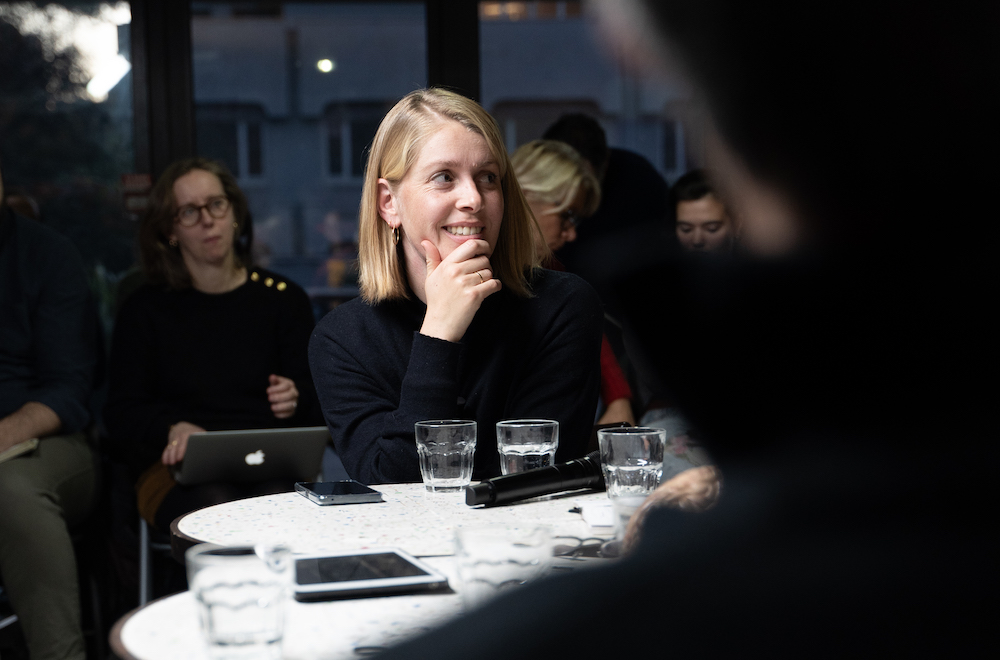
Mathilde Delespine
The story to re-create the link.
The story for sharing experiences.
In our work, in my work as a midwife more incipient, helping pregnant women to become mothers, couples to become parents. And work as a midwife helping women and their health, in the broadest sense, beyond just their pregnancy. And also helping women, victims of violence, help with her health issues, help with her rights, her legal and social rights.
We help her also establish connections with others beyond our professional team. Establishing connections with other women.
The story for mutual recognition.
It is important to allow mutual recognition, to put it simply, they will be able to feel understood, identify positively with other women.
Bodies and minds mistreated, to be rebuilt.
These women feel ashamed, because the shame of the violence they endured. Their bodies are numbed, disassociated: these women are disconnected from their bodies. So, we try to do this by creating a zone of security and trust, we adapt a lot to each consultation.
We, as health professionals, within a malfunctioning system, we also can be disconnected from our bodies. We can neglect our bodies, neglect our sleep, our health.
The story for resurrection.
We hear a lot of interpersonal violence and a lot of systemic violence. Systemic violence is the non-welcoming of people in exile who flee, as we would flee what they have fled. If we’d suffered what they’d undergone no doubt we would choose to flee also, if we had their courage. There are also women born here who suffer violence from the system which doesn’t sufficiently protect women victims of violence, children victims of violence.
We experience many emotions sometimes we share theirs, their anger, indignation…
Some women need to be resuscitated, medically, socially, legally, and they need to be boosted. Because when you undergo all that it’s so staggering it’s hard to believe.
The trauma destroys the representation of the world.
Trauma destroys our representation of the world and destroys meaning. That’s why it’s violent. It’s incomprehensible. It shouldn’t happen to a human being. So sometimes we see women who are almost lifeless yet they are alive. They’ stand there before us. But something has died.
Storytelling for integration.
And yet sometimes violence is also dealing with very contradictory rules. You have to integrate French life, you have to speak French, but the French classes are full. You have to be a useful refugee, be very knowledgeable, be useful to society. But as a refugee, I’m not allowed to work. The law forbids it. I’m allowed to do voluntary work.
It’s the big paradox: we do what we can, the best we can, with great commitment – because these women oblige us – with their resistance. Human beings are extremely adaptable and every day we see people who resist, who stand tall, we have no idea how. Of course, they motivate us.
Resilience & hope through speech & movement.
The co-animation of the talk groups or the therapy workshops with karate, theatre, art therapy or dance, there are also incredible moments very positive, joyful. We laugh sometimes during a consultation. Because it’s a thread of life. We have to go on living in spite of everything and that prevents violence from triumphing.
The possibility of telling, the power of listening.
Allowing these women to tell their story one way or another, when we try to just listen to them without being just health professionals who only write prescriptions, or jurists who only give advice, but first and foremost really listen, we’re trained to ask open questions. It’s not the victim of violence’s words freeing them, It’s our increasing ability to listen.
Opening the story.
We ask: “how are you?” Rather than say: “are you better today, Madame?” A simple example.
Confidence to free words.
The story begins when we say hello. It starts with her physical attitude. Because sometimes they can be very withdrawn with the slightest form of expression the story can start. When does it start? Certain women say: “with this baby, I want to start my life over. I won’t accept what I’ve endured ‘til now anymore.” And often the body expresses this. That’s when we see a new story.
Bifurcate to start a new story.
The perinatal period is so great because we know that traumas, stories of violence can be repeated from one generation to another. I wrote down “bifurcate”. We talked about that. What we try to do in creating this quality relationship with them as we try to help them feel that they deserve to be well treated, is to allow them to bifurcate onto a path of safety. So, they can maybe start new story – it won’t wipe out their past, what they’ve endured – but it can initiate a new way of relating to others, with the ability to act, with no submission or domination. Without being abandoned. That’s why we have to deliver, together.
The story: a seed to be sown.
The story begins as soon as we meet. But we need to be patient, we don’t always see a result from our efforts straight away. It’s like sowing a seed, sometimes it germinates immediately because the soil is ready. Sometimes not. You prepare the soil and it might be a colleague or a caring companion or a friend or a group of her peers who will sow the seed. She is the principle gardener. We’re there just to help her.
© Photos Brigitte Bouillot
Podcast: Play in new window | Download
